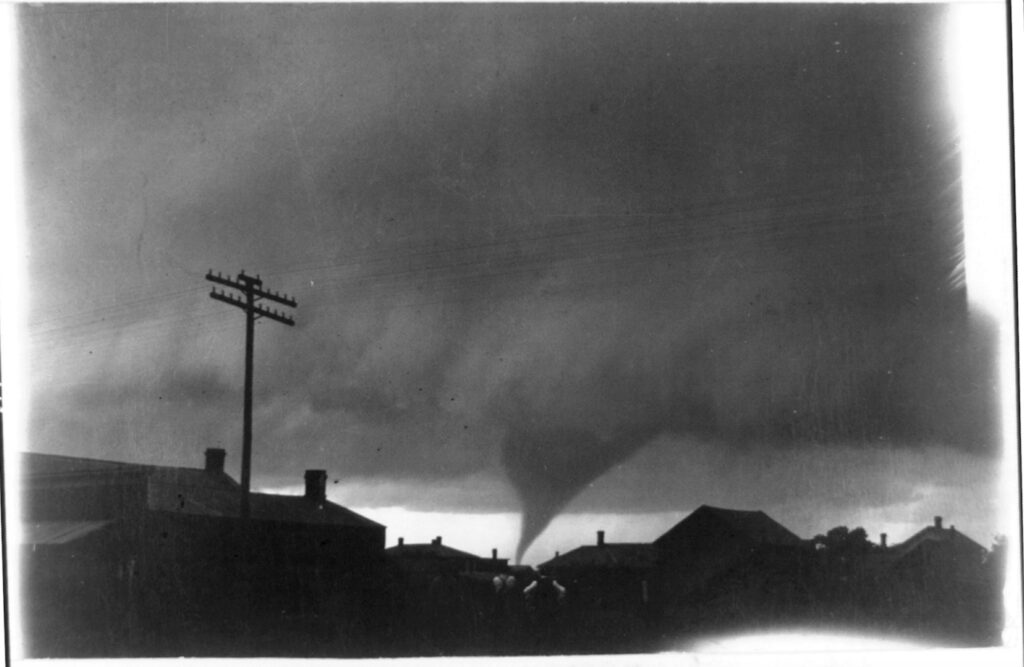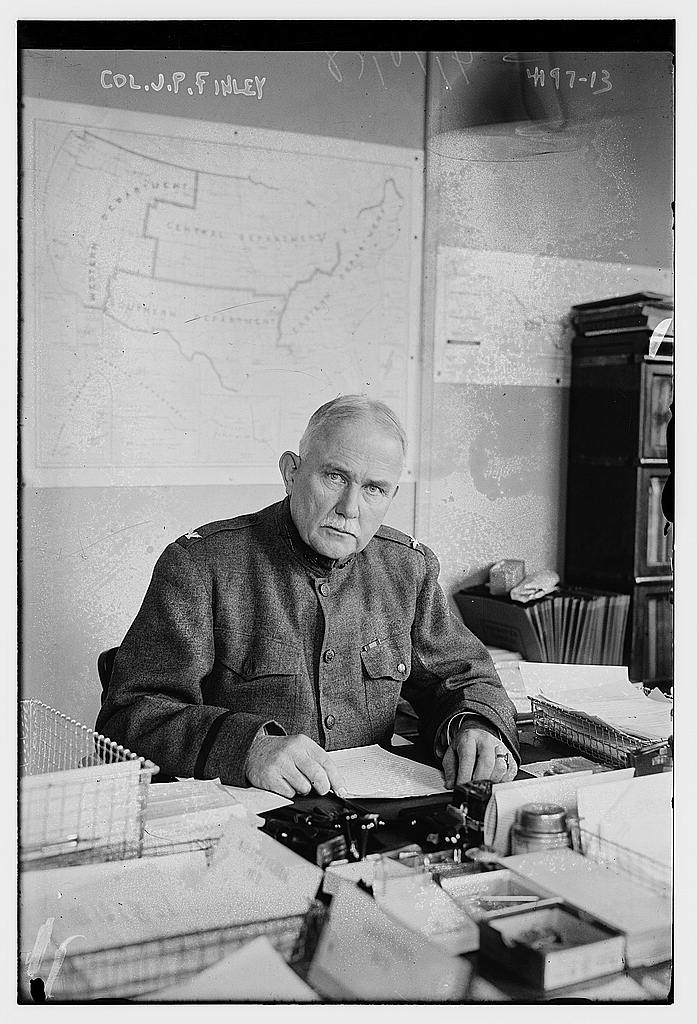Tornado forecasting was banned in the U.S. for 60 years. Why?

Here’s a bizarre piece of American trivia: From 1887 to 1950, the U.S. government banned the word “tornado” from weather forecasts. Warning the public about possible tornadoes would cause panic, officials said. It was better to avoid the word altogether.
The ban applied to all weather forecasters in the government, but there was one man in particular for whom the ban was designed: J.P. Finley, who in the 1880s began developing a promising new system of tornado forecasting.

A tornado in Kansas in 1902. (Source: Library of Congress)
The story of J.P. Finley
John Park Finley was the son of a Michigan farmer. He was built like a football player—six-foot-three and over 200 lbs.—with a storm-obsessed mind. He studied meteorology and climatology at an agricultural college before enlisting in the Army Signal Corps in 1877. (The Signal Corps ran national weather forecasting until the Weather Bureau was created in 1890.)
By all accounts, Finley was an expert in taking accurate weather readings and analyzing data. He quickly focused on tornadoes—specifically, how to predict where they’d land.
He began collecting and compiling hundreds of tornado reports, looking for patterns in weather conditions right before tornadoes touched down. If he could figure out which conditions created tornadoes, he could build a warning system so people could take cover.
His obsession with tornado forecasting bordered on unhealthy: At one point he found himself in an Army hospital, suffering from exhaustion. (“He is doing too much brain work,” the attending physician wrote. “He very decidedly needs rest.”)
1883 was a particularly bad year for tornadoes: 270 Americans died, underscoring the urgency of Finley’s project.
By 1884, Finley was operating out of Washington, DC, with almost a thousand “spotters” working for him in regions where tornadoes were more likely. He developed a list of rules about tornado-friendly conditions and began issuing experimental forecasts about where tornadoes would appear next.
Finley’s forecasts were not perfect: Sometimes a normal storm appeared where he had forecast a tornado. But in 1885, “tornadoes appeared fifteen of the nineteen times he had predicted them,” historian Marlene Bradford reports. One of Finley’s supporters, Edward S. Holden, started devising a way to use telegraph lines to alert homes about tornado conditions, in combination with a bell system and a cannon. Meanwhile, Finley “urged citizens in tornado-prone areas to become their own tornado forecasters by paying particular attention to the development of peculiar clouds on the western horizon on sultry, oppressive days from April 1 through the end of September,” Bradford writes.
But then, in 1887, Finley’s work as a tornado forecaster came to an abrupt halt: The Signal Corps forbade the word “tornado” in public forecasts. Government officials were worried the alerts would alarm the public unnecessarily. “[I]t is believed that the harm done by such a prediction would eventually be greater than that which results from the tornado itself,” the chief signal officer wrote in a report
When the U.S. Weather Bureau took over national weather forecasting from the Signal Corps three years later, it codified the ban on tornado forecasting. For those in government and their acolytes, it simply wasn’t worth it to warn people. “There is no material advantage to be derived from any, even the most perfect, system of forewarnings and attempts at protection,” a politically connected meteorologist named Cleveland Abbe wrote in 1899 in defense of the ban on tornado forecasting. (Abbe would later loudly take credit for being “the father of the Weather Bureau.”)
As for Finley: His meteorological career was long over by then. A few years after the government banned tornado forecasting, Finley asked permission to join his regiment and focus on military duties. Not only had his government superiors derailed his forecasting; they’d also criticized his passion for his work. Finley “is not successful with his subordinates,” one report read, “as he is apt to be unreasonable in his demands upon their time, expecting from all the same intense application he himself displays.”
His drive to push America into a new stage of learning and innovation—using scientific discovery, trial and error, and voluntary collaboration to save lives—led to Finley being pushed out of the government, with the doors to progress slammed shut behind him.

Finley in military service in 1917. (Source: Library of Congress)
The ban would remain in place for 60 years.
Meanwhile, tornadoes continued to drop out of the sky and kill Americans who were caught unaware. The same year Cleveland Abbe glibly defended the government’s ban on tornado forecasting, a tornado touched down in a Wisconsin town right on top of a visiting circus, killing 117 people.
It was exactly the kind of devastating loss of life that J.P. Finley had hoped to prevent.
Lesson learned?
Finley’s ill-fated tornado forecasting is a cautionary tale about government.
A historic innovation—from one of the government’s own experts!—was shut down for 60 years because of officials’ short-sighted risk calculations and fears. Finley’s superiors were more worried about public reaction to the forecasts than about what the forecasts might prevent. It was only during World War II, when the government needed to protect its own munitions and airfields, that officials realized how helpful a tornado warning system would be and developed it—for the military. Civilian communities around military bases soon learned how to recognize and pass the warnings on, and started clamoring for civilian tornado warnings. The government removed the ban on public tornado forecasts in 1950.
Alerts, of course, proved effective: Tornadoes are no longer inevitably catastrophic. Despite America’s population rapidly climbing, tornado deaths have steeply declined. Today the National Weather Service sends emergency warnings through mobile carriers to everyone in range of a possible tornado. J.P. Finley would be thrilled.
But that’s not the end of the story.
The government is still quick to ban or censor innovation out of fear about how the public will handle it. Drone businesses and websites that track rental pricing are being shut down in the early stages. Entrepreneurs and inventors are being frustrated by government barriers. Progress is being held up.
The lesson: When the government sees itself as a short-term protector of public order rather than the people’s own mechanism for defending their lives, liberty, and property, it fails. Even a public servant like J.P. Finley—energized and motivated to save lives—won’t be able to push progress forward if the system of government stands immovable against him.
(Photo at top: The Weather Bureau in 1924, during the tornado forecasting ban. Source: Library of Congress.)




